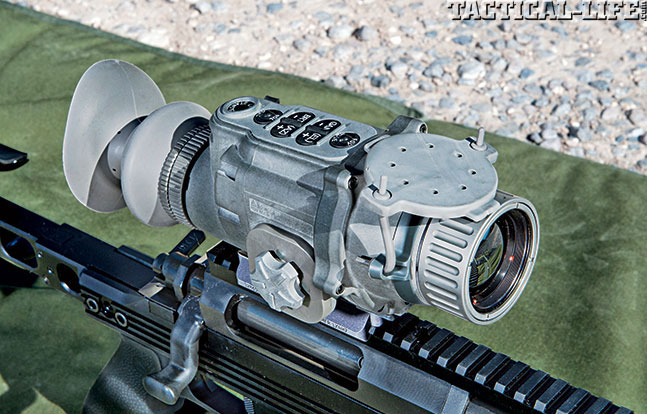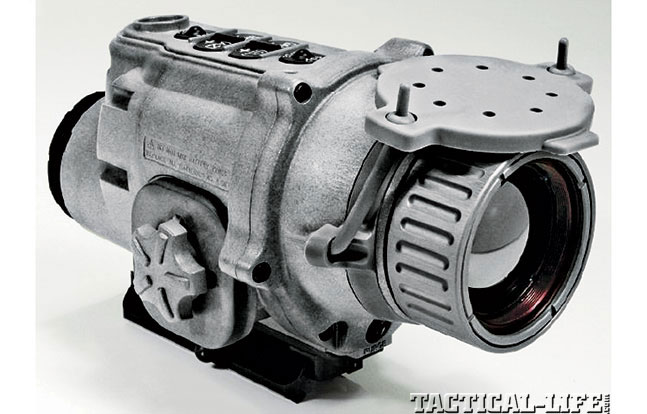One of my first chances to see and use thermal-vision equipment outside a helicopter was a unit secured by our fire department. While large, it was pretty amazing. No, you could not “see through walls” like many said, but it came very close.
Since the unit was secured by a fire captain at the time who was also a reserve on our SWAT team, we were able to test its tactical value. Though the unit lacked the definition to clearly identity a threat, it made it difficult for suspects to hide (especially in the snow). Even if they were hiding behind some light cover, they could be located. Thermal vision’s tactical applications were clear, but much like early night-vision gear, it was incredibly costly, and weapon sights were still restricted to the military.
Thermal vision displays light in the infrared scale. Simplistically, it reads the heat given off by any surface, person or living creature. A “phased array” of detectors scans the infrared scale. These detectors create a detailed pattern called a thermogram. This information is electronically translated into information that can be displayed on a screen. This allows thermal vision to be used in complete darkness or in daylight, and it can see through light rain, snow or fog. Not really a scope, it’s more like a camera with a display. Resolution can be pretty high depending on cost, and today’s image processors can provide for some striking definition. Like night vision, most thermal-vision units can be mounted in front of other optics—a spotting scope, a camera, a riflescope, etc.—or used as standalone devices.
Advertisement — Continue Reading Below
Those designed for weapons have reticles (crosshairs) that can be used when serving as the only optic. While relatively new to the civilian and police market, the military has been fielding thermal weapon sights for years. The first military-grade sight I used was in a laboratory. Able to clearly identify threats at 30 yards or so in pitch-black darkness, it was pretty amazing. It was also severely restricted and cost around $40,000—outside most LE budgets. That was several years ago, and much like night vision, these devices have come way down in cost. With each evolution, better devices have become available to law enforcement and even the civilian market. One such sight is the EOTech Light Weapon Thermal Sight (LWTS).
See the Heat
The LWTS is an ITAR-regulated thermal-vision scope available to U.S. citizens and law enforcement personnel. It can be used as a standalone device or in “clip on” mode (attached to other optics). Used by itself, the LWTS has 1x magnification with a 2x zoom. It acts more like a camera with a zoom feature than an “optic,” per se, when used alone. Attached to a scope, the LWTS utilizes that optic’s magnification and reticle. Four ballistic weapon reticles are available in clip-on mode—all are sightable to within 1 MOA. The unit’s 640×480 screen resolution is pretty good and can be focused from 3 meters to infinity. It includes an RS-170 real-time video input/output for remote viewing or recording. Designed primarily for use with low-power optics, the LWTS operates on four AA lithium batteries for a 10-hour run time. Weighing in at just under 2 pounds, it is lighter than many older models on the market.
Advertisement — Continue Reading Below
Rather than risk the unwanted attention of aiming a rifle in my neighborhood, I began testing the LWTS’ capabilities as a standalone device. Over the course of a week or so, I used it to make observations from my office, house, around the neighborhood and in pursuit of a critter or two on the range. It takes a few minutes to learn the operating instructions, but once you are familiar, it is pretty simple to use. Spend some time studying the LWTS’ manual—it will save some time.
Mostly measuring the LWTS’ ability to identify people, it worked very well at typical police ranges. From 50 yards and in, it was possible to clearly identify people known to me in the area. If I were deployed with the LWTS, it would be possible to identify most suspects or threats. It was excellent even when I used it to identify four-legged creatures. Having used much lesser quality night vision and thermal devices while hunting hogs, the LWTS is pretty amazing in low light. If you don’t have the need for fine details, clearly identifying a species is possible in almost complete darkness. This process also allowed me to figure out the unit’s basic operations like brightness, focus, gain and polarity (hot as black or white) prior to mounting the LWTS to a weapon. Adjusting the polarity so that the hotter something is the whiter it appears works best in daylight. In low light, in darkness or in cluttered areas, it worked best when hotter objects appeared as black. In other words, switch back and forth, and depending on the conditions your image may get clearer.
Range Performance
Advertisement — Continue Reading Below
At the range, I used two weapons platforms for testing the LWTS. The first was my Colt LE6940, to which I added the LWTS on its own. Mounting the unit was easy because of its throw-lever mount. I then chose the M4/M16 reticle and zeroed in. Once in adjustment mode, each press of the button moves the reticle one of two units depending on the field-of- view mode you are in (wide or narrow). At 25 yards, each “click” is 1 centimeter in the wide field of view and 0.5 centimeters in the narrow field of view. Once zeroed, there are ranging lines and aiming points for 300, 400 and 500 meters. There is also an M136 rocket launcher reticle and a 0.5-mil reticle for ranging.
Shooting at 50 yards, accuracy was commensurate with the limits of the rifle. It takes some getting used to, but the Colt/LWTS combo was plenty accurate for patrol work. Shooting steel targets between 200 and 500 yards was a blast. In the morning, the steel plates heated up under the sun, making them pretty easy to differentiate. For shooting at night, I attached a light stick to each plate, and once I figured out the hold, it was pretty easy to make hits on steel. Panning the range, it was also possible to pick up a furry critter or two, even in the darkness.
Next, I mounted the LWTS to an ArmaLite AR-31 precision rifle. A newly designed bolt action chambered in .308, it utilizes AR-10B magazines, making it well suited to most police operations. I attached the LWTS in clip-on mode in front of a Bushnell Elite Tactical SMRS 1-8.5x24mm scope with a BTR-2 reticle in the first focal plane. This scope provided plenty of magnification.
Advertisement — Continue Reading Below
Once placed in clip-on mode, the LWTS is automatically in its wide field-of-view setting. The AR-31 had already been zeroed at 100 yards. Adding the scope changed it less than half an inch, making it about dead on. I removed and reinstalled the LWTS three times, and the first shot was pretty much unaffected each time, making it perfect for team use. For most practical police uses, the LWTS/Bushnell combo would certainly be the ticket. Having the magnification of the scope provided some pretty incredible definition, especially at night at realistic deployment distances. Moving out to longer ranges, whacking steel out to 500 yards was a breeze.
Wrap Up
So, is the EOTech LWTS worth its MSRP of $12,000? From a deployment standpoint, definitely—if you have that kind of budget. And, if you don’t, EOTech has a grant assistance program to help agencies interested in obtaining the company’s products, including thermal-vision gear. That’s a big game changer, and if I could only choose night vision or thermal gear, the latter would be my choice. The LWTS can be used in daylight as a handheld device, by itself on a weapon or in front of your current optic. It is equally valuable on a patrol carbine as a precision rifle. The LWTS’ definition is rather astounding, especially at close range. It does not alter your zero appreciably when attached to your optic, and it held its zero throughout testing.
Advertisement — Continue Reading Below
Thermal vision really is the future of tactical optics. The LWTS is truly a mil-spec scope built to very high standards, making its $12,000 price tag pretty reasonable. Next time you go looking for night vision for your sniper unit or team, make certain you give this sight a hard look, too. For about the same price, it may be a far better option than current night-vision devices. Both would be great, but given today’s budgets, that may be hard. Either way, the LWTS truly is the next generation in weapon sighting. For more information, visit eotech-inc.com or call 734-741-8868.






























